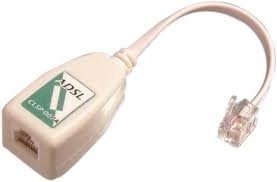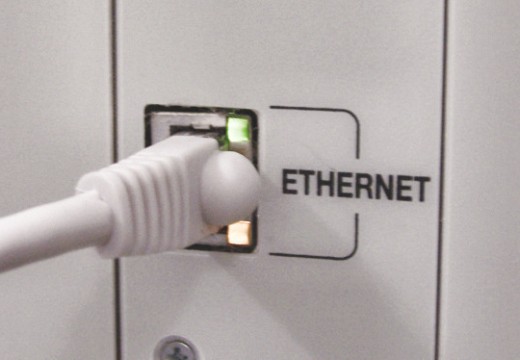ADSL Internet Access
Asynchronous Digital Subscriber Line (ADSL) is a broadband Internet option that is commonly available in many locations. Asynchronous only means that the download speeds and the upload speeds are different (with the upload speeds usually being significantly lower) and provides a fast option to browse the web. Internet access through ADSL requires one of three things. The first will be a dedicated phone line to access the ISP through the ADSL modem which some people do if they do not use a land based phone or simply purchase an additional line. The second option requires a technician to come in and physically modify a phone line to run on separate channels for ADSL Internet access and telephony voice access. The third and simplest option is to use an ADSL microfilter which electronically separates the signals to allow ADSL to work on a normal phone line.
Splitting the Phone Line with an ADSL Microfilter
The phone line requires the use of the special microfilter to allow for the ADSL modem to connect on a normal phone line. The ability of this filter to simply take the signal and sequester it from the other makes it possible to allow for both the functionality of the ADSL line and the analog phone line devices as well. Several ADSL providers will offer plenty of the required ADSL microfilters when subscribing to their service. The role of the ADSL microfilter is to split the following two signals:
Voice Signal – The voice signal is carried on the phone line at or under 4Khz. This means that the transmissions over this band are slower and not suitable for high speed Internet access through services such as ADSL. The microfilter makes it possible for voice signals to transmit alongside data signals without interference or crossing over of each one.
Data Signal – The Data signal is carried over bands that are anything over the 4Khz voice signal. This is possible to use for ADSL connectivity because these bands are faster moving and have the ability to carry more data over them than the 4Khz bands. Since the ADSL microfilter splits the data bands from the voice ones, it is possible to feed two types of signal through a single phone line.
Requirements in the home or Office for ADSL Connectivity
ADSL microfilters must be installed on every phone line that is used by analog devices. This includes but is not limited to the following devices:
Standard Analog Phones – The standard phone is used often by many consumers of phone lines and must be filtered properly to allow for ADSL access that is uninterrupted. Households or businesses with more than one telephone will require a ADSL filter for each one or else the signal being sent to the phone can easily disconnect or disrupt an active ADSL connection.
Wireless Analog Phones – These work the same as the normal phones but have a dock where they are charged which transmits the signal from the phone line. This is the same if multiple lines are used where multiple microfilters are needed to allow for the proper ADSL connectivity.
Answering Machines – Answering machines are popular but are being phased out by voicemail services. The same is true with using ADSL microfilters as each and every time the answering machine accepts a line connection to start recording, it will cause the connection to be interrupted. Filters can be attached directly to the RJ11 connector being used on the wall.
Standalone Caller ID Boxes – Sometimes caller ID boxes from third party vendors can cause disruptions on the line when they pull the caller information, even when no information is provided. By placing the appropriate ADSL microfilter in place, this will prevent unnecessary disconnects of the service.
Fax Machines – Fax machines connected through the same line as the ADSL will require the use of a filter. Every time a fax is sent or received, the signal can cause interference with the ADSL modem.
Cable Boxes – Some cable providers use phone access to pull up information and send charges made to the service through the receiver to the cable company. The installation of the proper filter prevents frequent disconnects when the line is shared with the ADSL modem.
Satellite Recievers – Satellite receivers are notorious for taking advantage of the phone connection to make updates to their system. The use of on demand programming and much more make frequent use of the phone line. This is why it is important to have the filter on the line which leads to the satellite receiver.
Troubleshooting ADSL Microfilters
Common problems occur with the ADSL microfilters and a few diagnostics and troubleshooting should be done before throwing the filter away and paying for new ones. This helps to save money for the consumer and saves on shipping for the ADSL service provider. One of the following common problems may be the culprit:
Improper ADSL Filter Installation – Sometimes the filter may be put in backwards or on a split phone line jack. This means that the filters must be rotated to the proper orientation and have the proper line put in.
Not Enough ADSL Filters – Not having enough ADSL filters and leaving devices which are plugged into the phone line which are active can make all of the other ADSL filters useless in the home or office. Getting more ADSL filters and installing them where appropriate can help to fix this problem.
Damages to the Filter – Some filters can be smashed or show physical damages such as wear or tears. These could leave exposed wires which are crossing signals on the line. The most common option is to replace the filter for better functionality from the service that is provided.
Phone Line Issues – Many phone lines are old and may not carry the signal well in the particular area. This cannot be fixed easily and requires that the technicians who deal with the phone lines to come and replace them. If you are well within reach of the ADSL company and have connectivity issues, it may be the phone lines.
ADSL Filters with Multiple Connectors
Fortunately, there are several ADSL filters which are designed with two jacks on the filter. One is specifically for the ADSL line to be plugged in while the other connects to the telephone or another device which uses the phone line to connect or communicate with the phone service provider or other people. These filters make it possible to make switching to ADSL easy to do.




Follow Us!